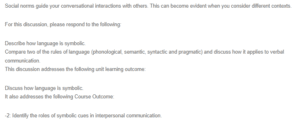The Impact of Social Norms on Verbal Communication
When learning a new language, one does not know the meaning of words of the new language, and, at that point, words seem like a bunch of letters put together until one learns what they mean. Essentially, in the beginning, the words are nothing but words and hold no meaning, either denotative or connotative. However, this changes the moment one learns what different words mean. Subsequently, after learning the meanings of different words, one can use those words to represent or rather convey various things, including ideas, objects, events, or feelings (Hamilton, 2016). Therefore, words or language are symbolic, which implies that they hold no meaning and can only be used to represent more abstract things, as mentioned above.
Syntax is one of the rules of grammar that applies to the structure of the sentence. Accordingly, this rule guides how words should be arranged to form a sentence. A subject-verb agreement, the correct order of words, and proper choice of words mark a strong syntax (Morrill, 2011). For example, in the sentence “The child sat on a chair,” the child is the subject, the chair is the object, and ‘sat’ is the verb. Eliminating either of these would make the sentence incomplete. On the other hand, another rule of language is semantics. Semantics is used to refer to the sentence’s meaning. For a sentence to make sense, it must be arranged in proper semantics (Morrill, 2011). For example, saying, “The chair sat on the child,” does not make sense. Semantics involves arranging a sentence in a logical manner. In verbal communication, syntax application takes place when one creates a connection between various things, such as an object and an action, to explain something. For instance, when telling a story about something that happened, one must create a connection between the event, the verb, and the subject, which refers to whom the event happened. Semantics also apply in verbal communication because there would be no communication when the words exchanged do not make sense. Without semantics, it would be just gibberish words being said, making the whole conversation meaningless and strange.
References
Hamilton, C. M. (2016). Communicating for success. Routledge.
Morrill, G. (2011). Categorial grammar: Logical syntax, semantics, and processing. Oxford University Press.
ORDER A PLAGIARISM-FREE PAPER HERE
We’ll write everything from scratch
Question

The Impact of Social Norms on Verbal Communication
Social norms guide your conversational interactions with others. This can become evident when you consider different contexts.
For this discussion, please respond to the following:
Describe how language is symbolic.
Compare two of the rules of language (phonological, semantic, syntactic and pragmatic) and discuss how it applies to verbal communication.
This discussion addresses the following unit learning outcome:
Discuss how language is symbolic.
It also addresses the following Course Outcome:
-2: Identify the roles of symbolic cues in interpersonal communication.

